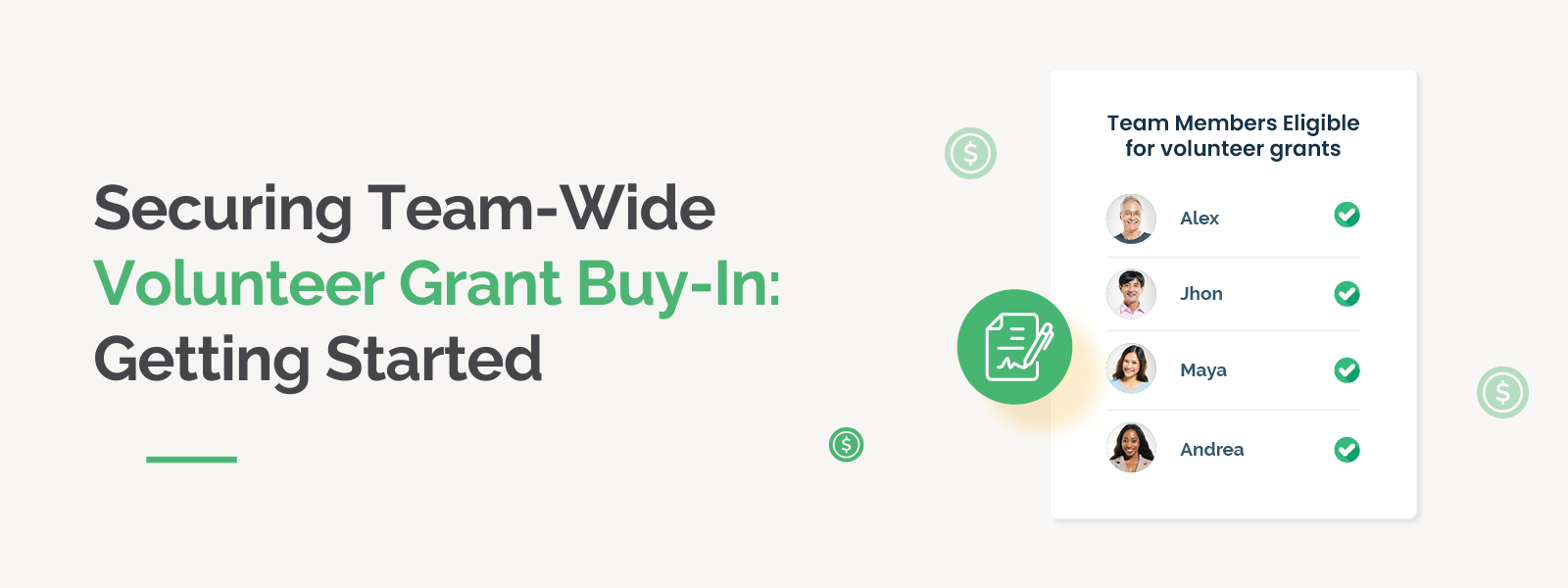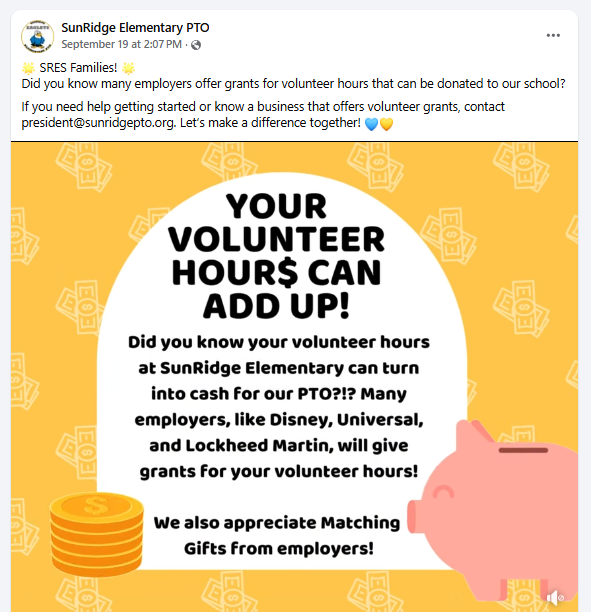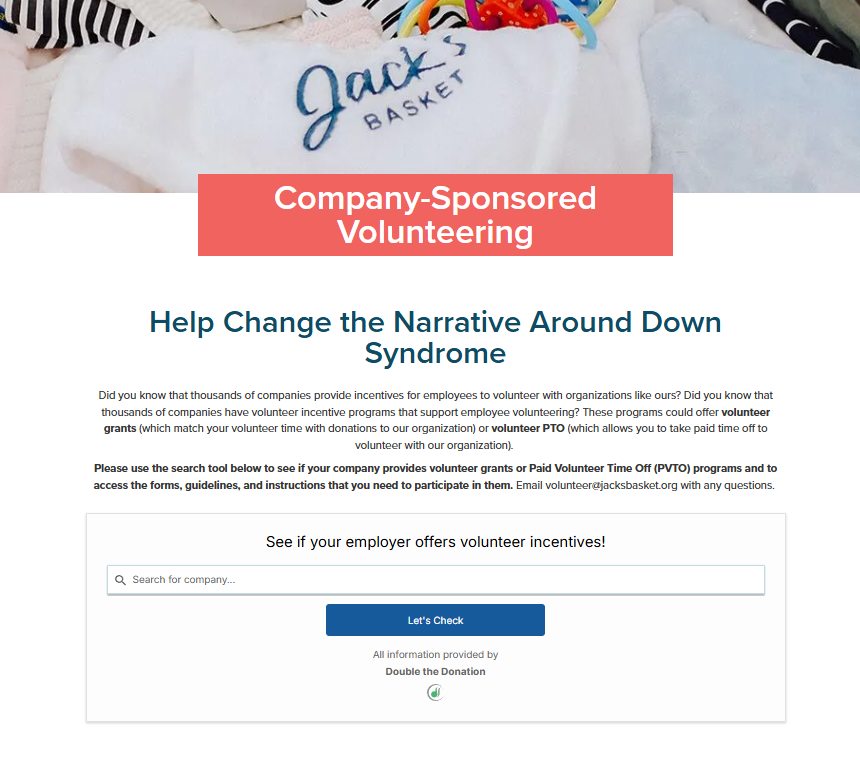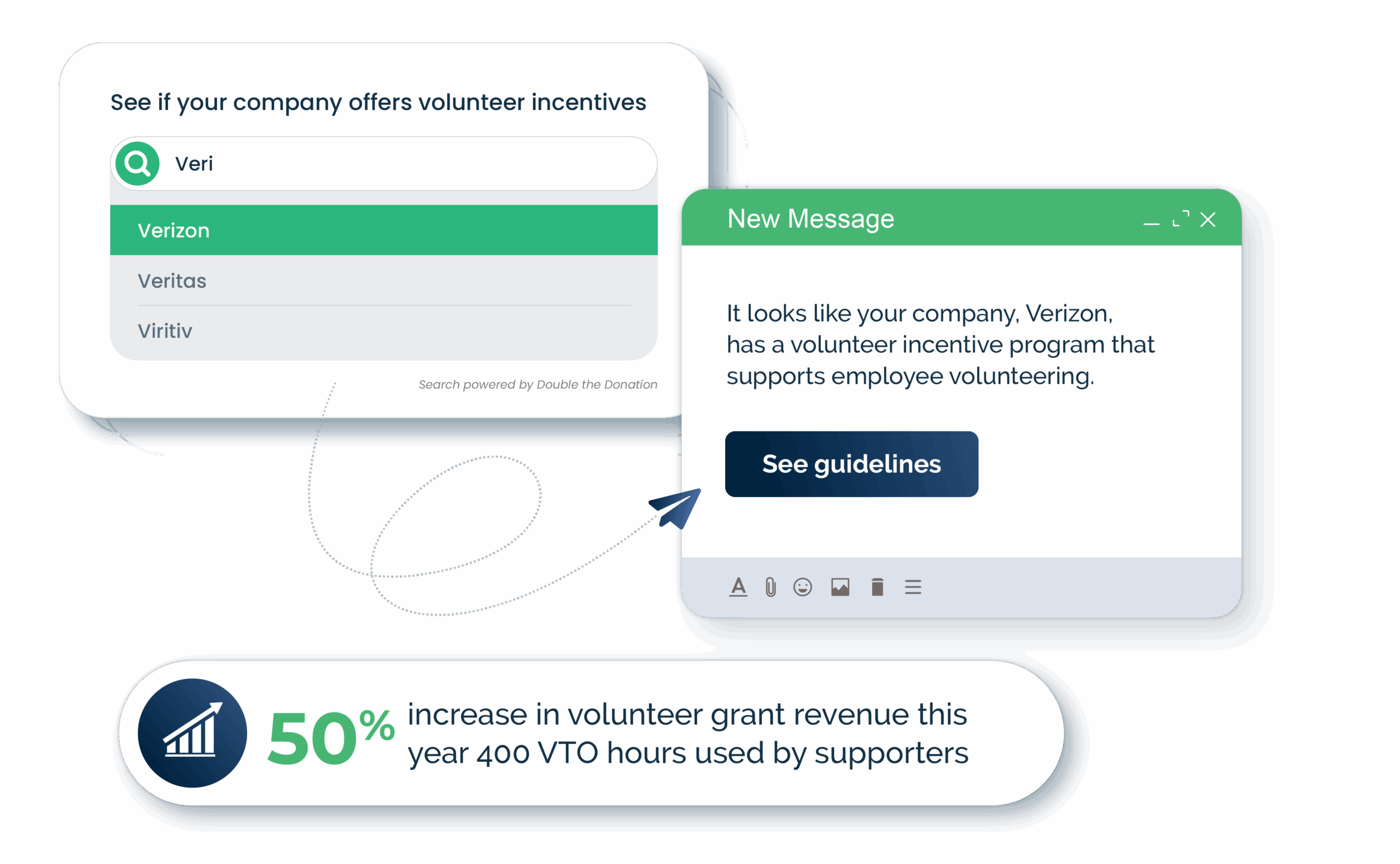Securing Team-Wide Volunteer Grant Buy-In: Getting Started
If you work in fundraising at a nonprofit, chances are your path rarely crosses with the volunteer department, if at all. Despite being part of the same mission-driven organization, these two teams often operate in silos, focused on different metrics, systems, and strategies.
But here’s the thing: their goals deeply overlap. Volunteers are often among your most loyal and engaged supporters, and many of them are even eligible for volunteer grants, a powerful yet often underutilized source of funding.
In this post, we’ll outline how you can actively build team-wide volunteer grant buy-in from the ground up, even if you’re starting from scratch (and volunteering isn’t currently in your wheelhouse). The steps we’ll cover include:
- Step 1: Acquire volunteer team buy-in.
- Step 2: Establish volunteer and fundraising team responsibilities.
- Step 3: Secure leadership buy-in.
- Step 4: Improve your processes.
Volunteer grants are a golden opportunity for fundraisers; but only if you can get the broader team aligned and engaged. Let’s find out exactly how you can do so!
Step 1: Acquire volunteer team buy-in.
Volunteer grants, or Dollars for Doers programs, are corporate giving initiatives where companies donate to nonprofits based on their employees’ volunteer hours. But here’s the catch: without coordination between your fundraising and volunteer teams, these grants often fall through the cracks.
If you’re on the fundraising team, the first step to unlocking volunteer grant revenue is starting a conversation with your volunteer department. Even if your teams don’t currently collaborate much, this is a natural area for partnership. After all, volunteers aren’t just helpful hands; they’re some of the most deeply invested supporters your organization has. And many of them are eligible for volunteer grants through their employers, adding extra monetary value to their support.
Opening the door to this conversation doesn’t have to be complicated. In fact, a simple outreach message that explains the opportunity and invites collaboration can go a long way.
Here’s a message template you can adapt:
Hey [Name],
Over on the fundraising team, we’ve been looking into corporate volunteer grants as a really valuable potential revenue stream for us. These programs allow companies to donate to nonprofits based on their employees’ volunteer hours; sometimes hundreds or even thousands of dollars per volunteer each year.
For example:
- About 40% of Fortune 500 companies offer volunteer grant programs.
- Some companies will donate $25+ per hour volunteered.
- Just 10 volunteers submitting grants could result in $2,500+ in unrestricted funding.
We’d love to explore how our teams can collaborate to identify eligible volunteers and support them in accessing these grants. Could we set up a quick chat to talk through this and see where there might be overlap?
Thanks so much!
[Your Name]
Bringing the volunteer team into the fold early helps ensure that systems are aligned, volunteers are supported, and no opportunity is missed. They’re the ones with direct access to the people who can make these grants happen, so your success depends on their partnership.
Step 2: Establish volunteer and fundraising team responsibilities.
Once you’ve obtained volunteer grant buy-in from the volunteer team, the next step is to define how your departments will work together to support the programs. There’s no one-size-fits-all structure here: the level of collaboration versus delegation will depend on your organization’s size, systems, and team capacity. What matters most here is clarity.
At some organizations, the volunteer team might take the lead on educating volunteers about grant opportunities, while the fundraising team manages the follow-up and tracking of submitted grants. At others, fundraising might handle most of the outreach, with the volunteers’ team simply providing support around eligibility and hour verification. Regardless of the structure, consolidating corporate giving across your team with clearly defined roles will make your efforts more effective and more sustainable.
Some key questions to answer together include:
- Who will be responsible for educating volunteers about grants?
- Who will verify volunteer hours (if required)?
- Who will track and follow up on submitted grants?
- How often will the teams sync up to review results or adjust strategy?
By mapping out responsibilities and connecting the right people across departments, you’ll create a process that feels smooth internally and supportive externally for your volunteers.
Keep in mind that if your organization uses a Volunteer Management System (VMS) that integrates with Double the Donation Volunteering, it’s especially important to loop in the right technical leads early on. In other words, make sure the person on the volunteer team who manages your VMS is connected with whoever manages your Double the Donation platform on the fundraising side. These platforms can work together to automatically surface volunteer grant opportunities, but only if the integration is properly configured and nurtured well.
Step 3: Secure leadership buy-in.
Getting internal support is easier said than done, but without leadership buy-in, even the most enthusiastic efforts to promote volunteer grants can stall. If your nonprofit is stuck at a “mixed buy-in” stage, where a few individuals see the value but there’s no organizational momentum, it’s time to shift your focus to leadership.
At this point, volunteer grants may not yet be on your leadership team’s radar; but they should be. These programs offer a scalable, low-lift fundraising stream that also deepens relationships with some of your most engaged supporters. When leadership understands and endorses this opportunity, it becomes much easier to secure staff time, facilitate cross-departmental collaboration, and even market real estate to promote these programs.
So, how do you get them on board? A targeted, data-informed approach is key.
Make the Case: Why Leadership Should Care
Start by reframing volunteer grants as strategic fundraising with built-in engagement. You’re not just asking for more tasks to be added to someone’s plate; you’re offering a pathway to increase unrestricted revenue while strengthening donor retention and volunteer loyalty.
Consider these high-level talking points:
- Volunteers are your most committed supporters, and many are eligible for corporate grants, which can be worth hundreds or even thousands of dollars per person on an annual basis.
- 40% of Fortune 500 companies offer volunteer grant programs, and some donate up to $25 or more per hour. Additionally, numerous smaller and mid-sized businesses also offer the programs, making it a significant opportunity for nonprofits like yours to leverage.
- These are untapped funds that already align with your mission and the work you’re doing. This represents a substantial amount of revenue that can provide a significant funding stream for your organization.
- Volunteers are more likely to donate, too. According to recent statistics, volunteers are over twice as likely to donate to nonprofits as non-volunteers. This shows that engaged volunteers are more invested in your cause and often more willing to support it financially.
- Companies are increasingly offering volunteer grants. This is a trend that continues to rise, reflecting the growing alignment of corporate social responsibility (CSR) efforts with employee engagement. In fact, studies show a 15% rise in companies’ volunteer initiatives as part of employee engagement since 2020, with the global employee volunteer participation rate increasing by 57% year over year, too!
Leverage Internal Data
In order to secure top-level volunteer grant buy-in, show leadership what’s already happening or what they’re missing out on. Instead of just talking about potential, visualize it by answering the following questions:
- How many volunteers are currently active each month or year?
- How many of them work at companies with known volunteer grant programs?
- If 10–20% of your volunteers submitted grants, what would the revenue impact be?
When possible, use tools like Double the Donation’s analytics dashboard (an invaluable asset within the Double the Donation workplace giving automation platform) to showcase potential revenue, real-time engagement stats, or missed opportunities.
Leadership is more likely to act when they see the numbers and understand the long-term return potential.
Keep the Conversation Going
When it comes to securing volunteer grant buy-in, obtaining initial approval is just the beginning. Request a regular slot in quarterly leadership or cross-departmental meetings to report on volunteer grant performance, highlight wins, and propose ways to improve the process. This might include:
- Marketing support for volunteer grant awareness – One of the most effective ways to keep volunteer grants top-of-mind is by ensuring ongoing marketing efforts that highlight these opportunities. You can request support from your marketing team to create materials, like flyers, email campaigns, or social media posts, that raise awareness about volunteer grants among both volunteers and corporate partners.
- VMS integrations or tech upgrades – If your nonprofit uses a volunteer management system (VMS) or other related technology platforms, integrating them with volunteer grant programs can streamline the process and increase efficiency. Propose potential upgrades or integrations with VMS tools (such as Double the Donation Volunteering) that allow for automated tracking of volunteer hours, volunteer grant eligibility, and request submissions.
- Team goals tied to volunteer grant engagement – Setting specific, measurable team goals related to volunteer grant engagement can help maintain focus on this revenue stream throughout the year. For example, you could establish KPIs (or key performance indicators) around the number of hours logged for volunteer grant eligibility, the amount of volunteer grant revenue generated, or the number of new partnerships secured.
Ongoing visibility ensures volunteer grants stay top-of-mind and that your nonprofit continues to treat them as a strategic revenue stream rather than an afterthought.
Step 4: Improve your processes.
Once your teams are aligned on their value and have started collaborating, the next step in securing volunteer grant buy-in is to strengthen the systems that support your efforts. Good processes don’t just make it easier for staff; they make it easier for volunteers to follow through.
Here are a few key ways to optimize your approach and ensure long-term success:
Drive awareness about volunteer grants with proactive marketing.
You can’t capture volunteer grants if people don’t know they exist, and, unfortunately, many don’t. Therefore, it’s crucial to develop a straightforward and consistent communication plan to inform volunteers about this opportunity so they can get involved.
For optimal results, try adding mentions of volunteer grant programs in key places like:
- Volunteer onboarding materials (such as registration forms, volunteer handbooks, etc.)
- Post-event (or post-registration) thank-you emails
- Monthly newsletters, whether physical or digital
- Social media posts on platforms like Facebook, Instagram, LinkedIn, and X
- And more!
Check out this example of one elementary school’s Parent-Teacher Organization promoting volunteer grants (and highlighting key employers) on its social platforms:
All in all, the goal is to normalize the idea that volunteering at your organization could lead to additional donations from their employer.
Make it easy to find volunteer grant information on your website.
One of the easiest and most effective ways to enhance volunteer engagement with volunteer grant opportunities is to add detailed information on your website, specifically on your “Volunteers” page. You’ll want to cover the basics of volunteer grants, a step-by-step overview of the process, and how supporters can determine whether they qualify for the programs.
In other words, it’s important to make it easy for volunteers to check their eligibility for grants! Luckily, Double the Donation’s volunteer plugin makes this possible by empowering supporters to…
- Search for their employer’s volunteer grant (and VTO) policies,
- Access specific eligibility and grant submission guidelines, and
- Get step-by-step instructions for submitting a volunteer grant request
All without leaving your site!
This seamless integration with the tool not only increases participation but also maximizes the value of your volunteer programs by tapping into the financial resources available through corporate volunteer grants.
Here’s an example of the plugin on the Jack’s Basket website:
For the best results, you’ll want to place the plugin on high-traffic pages such as your volunteer landing page, event registration and confirmation pages, and post-volunteering thank-you messages to meet volunteers where they already are.
Use your volunteer registration flow to identify eligible supporters.
Not to mention, if your organization signs up interested supporters by using a Volunteer Management System, connecting that platform to Double the Donation’s volunteer grant tools is a game-changer. After all, these integrations help automate eligibility checks, follow up with automated outreach, and streamline the grant request process, reducing staff workload while increasing your chance of capturing more grant dollars.
Take the following quiz to learn if Double the Donation Volunteering is right for you!
Use automated outreach to remind about volunteer grants.
For this reason, Double the Donation Volunteering offers automated email reminders that:
- Inform volunteers about corporate volunteer incentives
- Prompt eligible volunteers to submit their hours to their companies
- Include employer-specific instructions for volunteer grant submissions
- Are triggered based on volunteer activity to ensure timely, relevant content is received
- Link back to your volunteers’ page or corporate-sponsored volunteering resource for more information
These follow-ups are low-effort for your team (think: set it and forget it) but high-impact in terms of converting volunteer time into funding.
Track results and continuously make improvements.
Once your systems are in place, it’s essential to monitor their performance over time. In order to do so, keep an eye on key volunteer grant metrics such as:
- Number of volunteer grant submissions
- Total dollars raised through volunteer grants
- Leading employers of your volunteers
- Engagement rates with reminder emails
- And more!
From there, you can use this data to identify gaps and refine your strategy for more future successes.
Volunteer grants aren’t a one-and-done campaign; they’re an ongoing process of iteration and improvement. By investing in scalable processes now, you’ll set your team up to capture more revenue and make a stronger case for volunteer engagement in the long term.
Wrapping up & additional volunteer grant resources
Getting started with volunteer grants doesn’t require overhauling your fundraising strategy; it just requires a shift in how departments work together. While the volunteer and fundraising teams may have different day-to-day responsibilities, you’re ultimately working toward the same goal: building strong, lasting support for your mission. Acquiring volunteer grant buy-in can go a long way in achieving this goal.
By fostering collaboration, sharing resources, and helping your team see the fundraising potential behind volunteer engagement, you can unlock new revenue streams and deepen donor relationships. Volunteer grants are low-hanging fruit, but only if everyone knows where to reach.
Ready to expand your knowledge of volunteer grants? We recommend exploring the following additional resources:
- Access The Ultimate Guide to Corporate Volunteer Grants. New to volunteer grants? This comprehensive guide walks you through everything you need to know, from how these programs work to how your nonprofit can start capturing this often-missed funding stream.
- Top Volunteer Grant Companies Offering Dollars for Doers. Explore a curated list of companies with standout volunteer grant programs. Learn which employers are most generous, how their programs work, and tips for engaging eligible volunteers already supporting your mission.
- Top Volunteer Grant Databases to Grow Your Tech Stack. Looking to streamline the volunteer grant process? This post covers the best tools that can help you identify eligible volunteers, track hours, and submit grant requests, making your systems more efficient and scalable.








